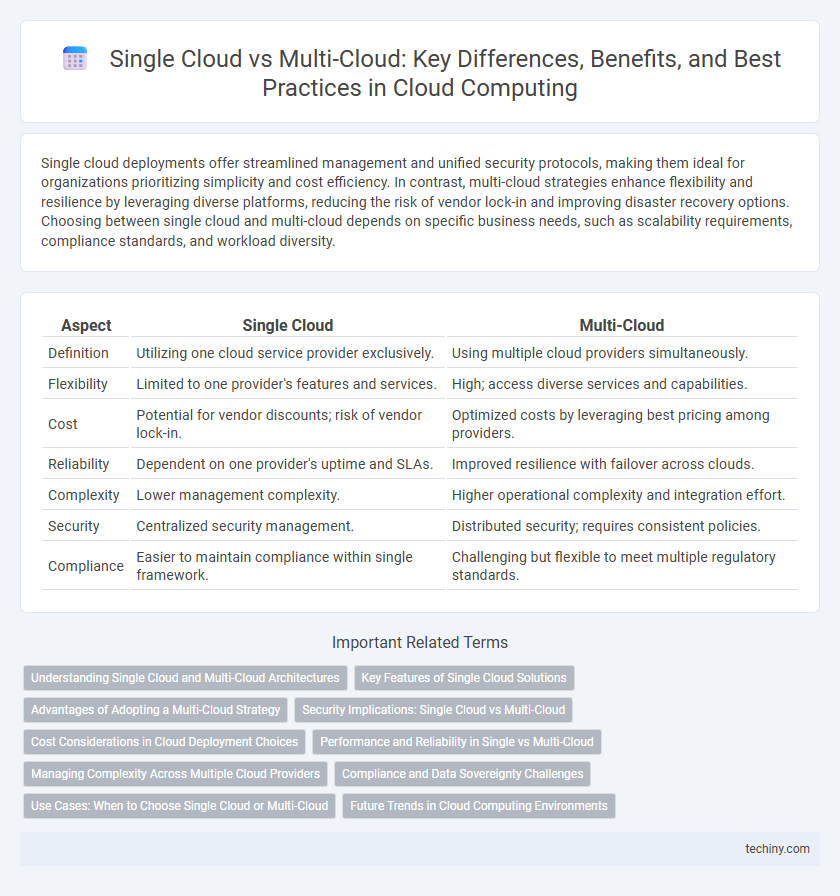Single cloud deployments offer streamlined management and unified security protocols, making them ideal for organizations prioritizing simplicity and cost efficiency. In contrast, multi-cloud strategies enhance flexibility and resilience by leveraging diverse platforms, reducing the risk of vendor lock-in and improving disaster recovery options. Choosing between single cloud and multi-cloud depends on specific business needs, such as scalability requirements, compliance standards, and workload diversity.
Table of Comparison
| Aspect | Single Cloud | Multi-Cloud |
|---|---|---|
| Definition | Utilizing one cloud service provider exclusively. | Using multiple cloud providers simultaneously. |
| Flexibility | Limited to one provider's features and services. | High; access diverse services and capabilities. |
| Cost | Potential for vendor discounts; risk of vendor lock-in. | Optimized costs by leveraging best pricing among providers. |
| Reliability | Dependent on one provider's uptime and SLAs. | Improved resilience with failover across clouds. |
| Complexity | Lower management complexity. | Higher operational complexity and integration effort. |
| Security | Centralized security management. | Distributed security; requires consistent policies. |
| Compliance | Easier to maintain compliance within single framework. | Challenging but flexible to meet multiple regulatory standards. |
Understanding Single Cloud and Multi-Cloud Architectures
Single cloud architecture leverages a single cloud service provider to deliver computing resources, offering simplified management, consistent performance, and integrated security features. Multi-cloud architecture utilizes multiple cloud providers, enhancing redundancy, avoiding vendor lock-in, and optimizing cost and performance across diverse platforms. Understanding these architectures is crucial for designing scalable, resilient, and cost-effective cloud solutions tailored to organizational needs.
Key Features of Single Cloud Solutions
Single cloud solutions centralize resources and management within a single provider, offering streamlined integration and simplified billing. They provide consistent security protocols, dedicated support, and optimized performance through tailored infrastructure. This unified environment facilitates easier compliance and reduces complexity compared to multi-cloud deployments.
Advantages of Adopting a Multi-Cloud Strategy
Adopting a multi-cloud strategy enhances redundancy and reduces the risk of vendor lock-in by leveraging multiple cloud providers for diverse workloads. This approach improves disaster recovery and optimizes cost efficiency through competitive pricing and tailored services. Enterprises gain greater flexibility and scalability, enabling them to select best-of-breed solutions aligned with specific business needs.
Security Implications: Single Cloud vs Multi-Cloud
Single cloud environments centralize security management, simplifying monitoring and compliance but increasing risk due to a single point of failure. Multi-cloud strategies diversify security risks across multiple providers, reducing vulnerability to provider-specific breaches while complicating unified policy enforcement and threat detection. Organizations must balance these trade-offs, considering factors such as data sensitivity, regulatory requirements, and incident response capabilities.
Cost Considerations in Cloud Deployment Choices
Single cloud deployments often offer streamlined billing and volume discounts, reducing overall costs through provider-specific reserved instances and committed use contracts. Multi-cloud strategies can incur higher expenses due to complex management, data transfer fees between providers, and the need for specialized tools to handle interoperability and security across environments. Assessing workload requirements and forecasting usage patterns is essential to optimize cloud expenditure and avoid unnecessary overhead in either deployment model.
Performance and Reliability in Single vs Multi-Cloud
Single cloud environments often deliver consistent performance due to optimized infrastructure and tightly integrated services, reducing latency and improving resource management. Multi-cloud strategies enhance reliability by distributing workloads across multiple providers, mitigating the risk of downtime from a single point of failure and ensuring higher availability. Performance in multi-cloud setups can vary, necessitating sophisticated load balancing and traffic management to maintain efficient operations across diverse platforms.
Managing Complexity Across Multiple Cloud Providers
Managing complexity across multiple cloud providers requires advanced orchestration tools and unified management platforms to ensure seamless integration, consistent security policies, and efficient resource allocation. Single cloud environments simplify operations by offering centralized control, but multi-cloud strategies enhance redundancy, mitigate vendor lock-in, and optimize workload distribution across diverse infrastructures. Effective multi-cloud management hinges on robust governance frameworks and automated workflows to handle disparate APIs, compliance standards, and performance monitoring.
Compliance and Data Sovereignty Challenges
Single cloud deployments simplify compliance management by centralizing data within a single legal jurisdiction, reducing complexity related to data sovereignty regulations. Multi-cloud strategies introduce challenges in maintaining consistent compliance due to varying regional data protection laws and diverse cloud provider policies. Ensuring data residency and sovereignty across multiple clouds requires comprehensive governance frameworks and continuous monitoring to mitigate regulatory risks.
Use Cases: When to Choose Single Cloud or Multi-Cloud
Single cloud environments excel in use cases requiring streamlined management, consistent performance, and cost efficiency, such as small to medium-sized businesses or applications with predictable workloads. Multi-cloud strategies suit enterprises needing redundancy, risk mitigation, and access to best-of-breed services across providers, ideal for disaster recovery, regulatory compliance, or leveraging innovative AI and machine learning tools from multiple vendors. Evaluating workload diversity, data sovereignty requirements, and vendor lock-in risk guides the decision between single cloud and multi-cloud deployments.
Future Trends in Cloud Computing Environments
Future trends in cloud computing emphasize increased adoption of multi-cloud strategies to enhance flexibility, resilience, and cost optimization by leveraging services from multiple providers like AWS, Microsoft Azure, and Google Cloud Platform. Advances in AI-driven cloud management tools and automation are expected to simplify multi-cloud orchestration, improving workload distribution and disaster recovery capabilities. Security frameworks designed for multi-cloud environments will evolve, addressing compliance and data sovereignty challenges as enterprises distribute resources across diverse cloud infrastructures.
Single Cloud vs Multi-Cloud Infographic

 techiny.com
techiny.com